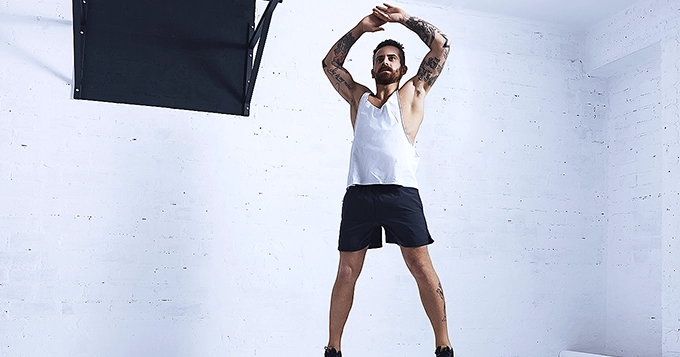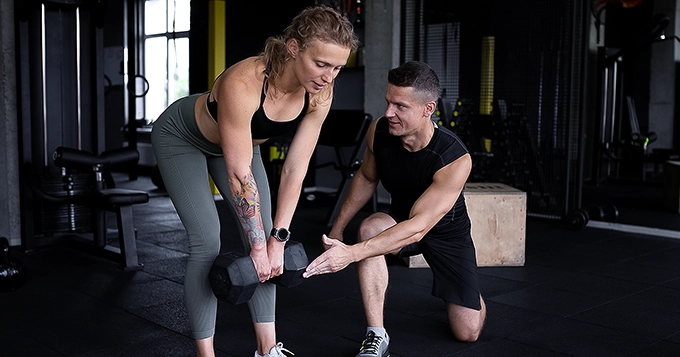Embarking on a fitness journey is an exciting experience, but avoiding exercise mistakes is crucial to ensure progress and prevent potential setbacks. In this article, we’ll explore some common workout mistakes people make in their workout routines and provide valuable tips for preventing them.
Skipping the warm-up
First on the list of common exercise mistakes is not warming up your muscles. This can make you very vulnerable to injury.
Warm-ups get your blood flowing, increase body and muscle temperature, and increase muscle elasticity, which will help you avoid injuring cold muscles. Having cold muscles means that your muscles are not warmed up and are not at all prepared for activity.
Tip: Your warm-ups shouldn’t be just any exercise. They should be related to your workout. For example, if your workout focuses on squats, try hip-opening dynamic stretches like jumping jacks in your warmup. These moves increase blood flow to the lower extremities and prepare your body for the movement patterns in your workout.
Skipping the cool-down
Most people don’t have ample time to exercise, so some just skip cool down. But this is not recommended.
If you suddenly stop exercising and skip cooling down, your muscles will suddenly stop contracting. This can cause blood to pool in your legs, causing less pressure for your blood to be pumped back to your heart and brain.
Cooling down after exercise helps initiate the recovery process and might assist in eliminating lactic acid from your muscles. Lactic acid, a byproduct of physical activity, can contribute to soreness after a workout.
Tip: Your cool-down should include passive or static stretches that involve the muscles you just worked – for around 5 to 10 minutes. For example, if you just did a lower-body workout, you can do static movements such as hip-flexor or hamstring stretches.
Ignoring proper exercise form
One of the common workout mistakes is not adhering to proper form.
Improper exercise can put unnecessary stress on our joints and tendons. This could lead to acute injuries such as sprains, strains, and muscle tears, as well as chronic issues like joint pain, muscle imbalances, and overuse injuries.
In a small study, scientists examined shoulder injuries among people who engaged in high-intensity training. One of the prevalent reasons for injuries was identified as improper form. Therefore, it is vital to understand the correct technique for each exercise in your routine.
Tip: For beginners in resistance training, start with bodyweight movements such as push-ups, squats, and lunges instead of free weights. You can master these moves before using weights or exercise machines. You can also book a session or two with a personal trainer who can show and teach you the proper techniques.
Not properly hydrating
It’s important to replace fluids lost through sweat when you exercise. Losing more than 2% of the water in your body causes dehydration, which can impact your exercise performance and recovery.
Tip: The American Council on Exercise suggests that you:
- Drink 17-20 oz of water 2-3 hours before exercise.
- Drink 8 oz 20-30 minutes before exercise.
- Drink 7-10 oz every 10-20 minutes during exercise.
- Drink 8 oz 30 minutes after your exercise.
Not resting and recovering
Muscle soreness could indicate that your muscles are still recovering after your workout. This can also mean that your muscles are adjusting to the exercise.
Not properly resting can disrupt your body’s natural responses. Your body cannot recover or build new tissues if you do not give it the rest it desperately needs to perform that hard work
Tip: The time you need to rest and recover after exercise depends on how hard you work out. Research suggests that giving your muscles about 48 to 72 hours of rest is ideal for repair. So, it’s recommended to take at least two days off each week before working the same muscles again. Also, don’t forget to replenish lost calories and water after exercising.
Thinking of exercise as a chore
Your fitness journey is a process. Not choosing exercises you like is one of the workout mistakes that can slow down this process. In some cases, it can make you quit your exercise completely. Lack of enjoyment is one of the reasons why many adults don’t get enough exercise.
Tip: If you often feel like skipping the gym, it can be a sign to try something different. Research suggests that enjoying your exercises is vital for forming habits. So, picking workouts you like can boost motivation and help you stick with them. You can also track your progress for extra motivation whenever you see concrete progress toward your goals.
Other ways you can enjoy working out include the following: training with a friend, listening to music, watching your favorite show, or rewarding yourself after you’re done with your fitness routine.
Sticking to the same workout
Once you find a workout you like, it can be tempting to stick with it forever. But that can lead to a common mistake: hitting a plateau. Doing the same exercise over and over helps your muscles to adapt to the movement and get better at it, but changing things up can prevent boredom and keep you moving toward your fitness goals.
Tip: Experiment with fresh activities or explore various methods and tools. You can also increase your reps or move to heavier weights.
Changing your workout too often
Yes, the previous tip talks about sticking to the same workout, which is not ideal. But be careful not to switch your routine too often. Your body might not receive enough stimulus to see significant improvement if you keep changing your exercise routine so frequently.
Tip: You can continue with the same program for approximately 4 to 8 weeks as long as you’re witnessing positive results before considering any modifications. You can gradually increase the intensity, frequency, or duration of your exercises.













